A Brief Town History
PRE-NORMAN TIMES
In 1869 and 1881 workers digging on the south slopes of Broad Hill came across 2 granite lined chambers 12m apart. The second one was better preserved with yellow plaster and red and black stripes painted on the wall with here and there hints of a red on white pattern too. Shards of bone and oyster shells on the floor of this second chamber, along with pieces of Swithland slate that might have at one point formed a roof. The next earliest finds in the area come from a team of workers excavating on the same hill in 1892 who came across an historic well containing Romano-British ceramics, animal bones and a metal plated bucket. This has been dated to the 3rd or 4th century CE and indicates a local population in this period.
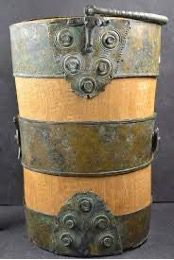
As for the next period of English history, the arrival of the Angles in the area in about the 5th century CE, there has been very little or no history discovered about our part of the kingdom of Mercia, (although anything on Castle Hill would likely have been destroyed by the later Norman building works).
THE CASTLE, THE REVOLT OF 1173 AND THE FIRST BARONS’ WAR
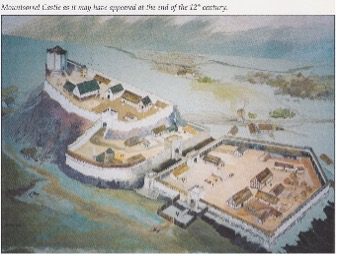
By far the biggest impact on the area by the Normans after their invasion of 1066 was the construction of castle on the rocky hill overlooking the valley below. There is no mention of the town or manor of Mountsorrel in The Conqueror’s Doomsday Book of 1086, but the manors of Barrow and Rothely DID exist and the castle pretty much sat on top of the border with the division itself likely up the line of what is now Watling Street. Barrow was under the control of the Earl of Chester, whilst Rothely to the south fell was part the Earl of Leicester’s territory. These two Earl’s had an ongoing private war and the castle’s ownership would form a large part of that.
The County antiquarian John Nichols writing in c1800 says the castle was probably constructed in about 1080 by Hugh d’Ávranches, Earl of Chester (also called Hugh Lupus and Hugh the fat) modern historians’ question this and think it may have been in the control of the Earls of Leicester from the outset. It was certainly in Leicester control at the time of the lengthy private war between the Earls and caused by Leicester taking over tracts of Chester lands. The peace treaty and follow-on non-aggression pact negotiated by the Bishop of Lincoln leaves the castle in Leicester’s hands but gives Chester access to it and the Borough of Mountsorrel.
In 1173 the 3rd Earl of Leicester sided with a rebellion again King Henry II in the name of his eldest legitimate son (also called Henry). After a siege in 1174 the castle was taken over by the King and even after the Earl of Leicester repented and gained most of his lands back, the King still kept hold of Mountsorrel Castle, much to the annoyance of the Earl’s family.
The castle remained in the King’s possession until being granted to Saer de Quincy by the then current king, King John. Unfortunately for the King, at the start of the First Baron’s War, de Quincy sided with the rebel barons who were trying to place Prince Louis of France on the English throne in King John’s stead and the castle became a rebel stronghold (again). Raiding through the local area to support the garrison, the castle gained a reputation of being “a nest of the Devil and den of thieves and robbers”- very flattering!
King John’s death in 1216 didn’t stop the rebellion, and his 9 year old son was crowned Henry III whilst guided and guarded William Marshall, 1stEarl of Pembroke who was effectively the Regent. Marshall was supported by Ranulf de Blondeville, 6th Earl of Chester, who was despatched with several other leading loyal barons to recover the castle.
During the ensuing siege in April-May 1217 Chester’s scouts reported the imminent arrival of a large French relief force and he pulled his forces back to Nottingham. The report was in error as it was only half the French army who arrived at Mountsorrel, they secured the castle for the rebels and then pillaged their way across the Vale of Belvoir and on to Lincoln to join the rebel siege of the castle there.
William Marshal now joined with Chester circled round to the west of Lincoln, entered the castle and then trapped the rebel baronial and French forces those forces inside the city walls below the castle. There Marshall and Chester personally led a bloody assault against them during which the Marshall of France, Comte Thomas de Perche was killed and the rebel forces crushed in the battle now known now as “The Lincoln Fair”. The defeat led eventually to Prince Louis giving up his (tenuous) claim to the English throne and departing for France; later that year Ranulf de Blondeville was also given the newly created title 1st Earl of Lincoln – to the victor go the spoils
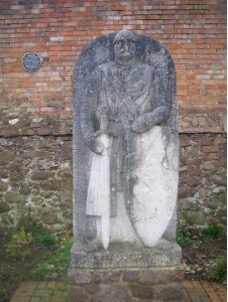
Having been held against the crown twice in a little over 40 years, the King decided that the castle was a far too valuable and strategic an asset to let fall into the wrong hands again. In the aftermath to the battle he gave control to the Earl of Chester who rode south and ordered it razed to the ground.
During the years of the castle’s presence on the hilltop, a small village would have grown up around it to service the needs of its residents and garrison. Forming a rough triangle, this village would have formed around what is now Market Place to the east along the valley road, The Green to the south and Watling Street to the north of the castle itself.
THE ENGLISH CIVIL WAR
In March 1644 a small Royalist force had been sent towards the Parliamentary held city of Leicester in order to bottle up the garrison to prevent them from joining in a defence against the main Royalist force under Prince Rupert and Lord Loughborough which was trying to get to Newark to relieve the city there from a Parliament siege.
After successfully completing this mission they withdrew northwards to Mountsorrel where they billeted and rested in the local inns.
On March 15th a Parliamentarian force moving up the east bank of the River Soar, came across the Mountsorrel troops and attacked across the bridge into the town (this crossing once stood where the 2 bridges next the Waterside pub and the canal lock gates now stand). After initially securing the town centre the Royalists had to withdraw after their expected reinforcements failed to show up.
Paragraph about the relief commander being a self-centred dandy with no real interest in the campaign and a possible dislike of the other commander (?) who had decided to stay in Leicester. He was later court martialled and dismissed. Info in the Civil War in the East Midlands book.
The 2 forces, now on opposite sides of the river, steadily moved north towards Loughborough where the Royalists had hoped to cross on their way to Newark and where the Parliamentarians intended to stop them.
In Loughborough on 18th March the Parliament forces charged over the barricaded Cotes Bridge and forced the 2000 Royalist soldiers under Lord Loughborough to fall back. That evening however, Prince Rupert arrived to reinforce Loughborough and the Royalists seeing all hope of victory evaporate with this new force of an additional 3000 men joining the fight withdrew back over the bridge. On March 19th The Royalists crossed the bridge and headed towards Rempstone. The following day Loughborough and Prince Rupert continued their advance to Newark where they encircled the Parliamentarian army and defeated it. It is quite possible that if the Parliament forces had taken and held the bridge at Mountsorrel then they could have pushed a force over it to outflank the Royalists at Loughborough, or at least delayed the arrival of Prince Rupert – The siege at Newark would then probably have had a different outcome and the war taken a different course much earlier than it did.
THE MARKET
On 14th July 1292, the Lord of the Mountsorrel Manor, Nicholas de Seagrave, was granted the right by Kind Edward I to hold a market every Monday and a yearly fair on the “eve and morrow of St John the Baptist and 5 days after“. The popularity of the fairs seems to have died away in the 15th century but once more became busy again with more houses being built along Main Street (Loughborough Road now) in the 1600s.This fair lasted until 1873.
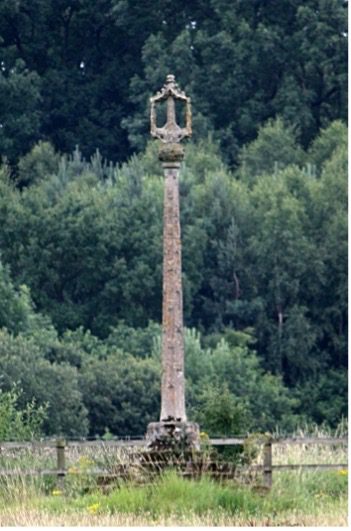
In 1793 the Lord of the Manor, Sir John Danvers, removed the ancient market stone cross from the junction of Watling Street and Market Place, around which the market would have been centred, and moved it to his estate at Swithland where is still stands. He replaced this with a purpose built stone pergola in the same location which remains to this day. The market continued to be held on this location with it’s heyday in the 19th century with the locally produced “Mountsorrel gloves” much in demand,
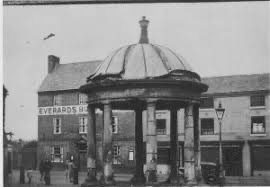
A replica of the original Butter Cross was commisioned as part of the Parish Centenary celebrations in 1994 and completed by local artist Michael Grevatte (who lived at some point on Watling Street); it now stands proudly outside the Peace Gardens at the junction of Sileby Road and Loughborough Road close to the town centre. Moving the original Butter Cross back to the town was looked at, but sadly the monument is now far too fragile to withstand another move.
Although the original fair was discontinued in 1873, the town continued to hold sporting events and parades bringing together the surrounding communities until the early 20th century. This tradition has been rekindled in recent years with the “Mountsorrel Revival” being held on the 2nd Sunday of each August since 2016 and has continued to grow year on year ever since!
TRANSPORT
Being located on the main route north/south along the Soar Valley, Mountsorrel has always been linked to transport passing through the area, be that in defence and control by the castle or as a natural route for the later main road (or turnpike as it was know in earlier times), the canal and the railway.
The Turnpike
Since Medieval times there has always been a road running north-south along the raised western bank of the River Soar valley; historically there have been only limited places where crossing of the river is possible, and Mountsorrel sits on one of them. Before the river was canalised for easier transport the land to the north of the town towards Loughborough was likely marshy due to the low lying flood plain, a road from the east (the old Slash Lane) passed over this bridge/ford up the embankment beyond to the main road.
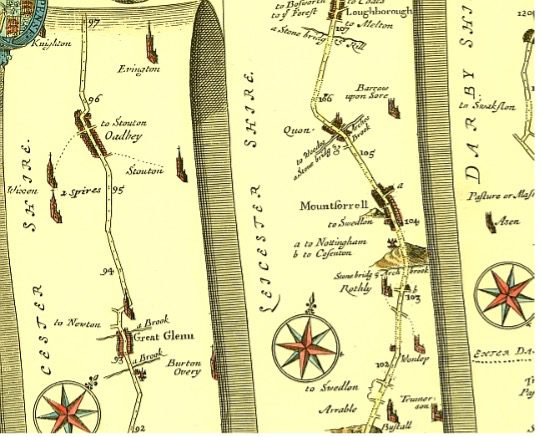
A turnpike road was in essence a toll road where the tolls changed would be used to maintain that section of road. The UK’s first ever turnpike was built between London and western Scotland in 1726, and in our area this ran through Market Harborough, Leicester and then onto Loughborough (this was MUCH later renamed the A6). The toll station to the south was in Leicester on Belgrave Road near the market, and the one to the north was in Quorn, situated approximately where the mini roundabout next to the White Horse pub is (later moved to the junction of Woodthorpe Lane in Loughborough). To support the travellers and cash in on this route many coaching inns were built along the road and two can still be seen in the town, The Swan Inn (formerly the Nags head) and what was The Grapes hotel (now 2 houses); both of these still show the old coach entry archways.
The Canal
With the advent of the Industrial Revolution, a means of transporting coal, iron ore and other valuable heavy bulk goods between the factories, mines, kilns and forges was needed, as well as a means of delivery the final products to the rapidly growing cities and their growing demand.
As the road network of the time was unsuitable for heavy wheeled transport (especially fragile goods), a vast network of canals was built. The River Soar was made navigable as far as Loughborough as a branch of the Grand Union Canal in 1780 and was extended through Mountsorrel to Leicester by 1794.
Locally quarried granite would have be brought down to the canal by horse drawn cart where it was loaded into the canal’s narrowboats. As the main quarry at the time was Broad Hill, the route would have taken the carts down Watling Street, through Market Place to the canal’s dock on Main Street (now named Loughborough Road).
The Waterside pub sits alongside the canal’s lock gates, this was called the Duke of York since its building in 1795 until Everards Brewery changed it in 1965. According to an advert for the pub when it was sold in 1869 it had “stabling for 12 horses, piggeries, with numerous offices, with garden and orchard”.
A loaded narrowboat would take 2-3 days to get to London with a full load of granite assuming it could travel through the night, or more likely up to a week if restricted to daylight travel only, this was a huge improvement over the nightmare of trying to get loaded heavy wagons over the rough mostly unpaved roads of the time. The glory days of the canals was not to last long though!
The Railways
The Soar valley didn’t only provide a logical route for roads and canal transport but also from the mid-1800s the new steam powered railways. In 1839, the Midland Counties Railway (MCR) drove their line southwards through the valley from Derby and Nottingham down through Loughborough, Barrow, Sileby and Leicester and then onwards to Rugby; this was opened in our area on May 4th 1840. The financially struggling new company merged with 2 other local railway companies in 1844 to form the Midland Railway (MR). Our local section of line has been in constant operation since as part of the Midland Mainline.

(North in downwards on this map…)
These early railways’ main income was always going to be from the transport of freight rather than passenger traffic, and in 1858 an act of Parliament was passed allowing the creation of the “Mountsorrel Railway” which would link this main line to the Mountsorrel granite quarry. As part of this spur an 80yard long brick viaduct was built over the river over which the rail line ran. This is still in existence toady still bearing the date 1860 in which it was completed. The bridge continued to carry quarried granite by rail to the Sileby sidings until the 1977 when the track was removed and replaced by a conveyor belt. This belt is still in use today.
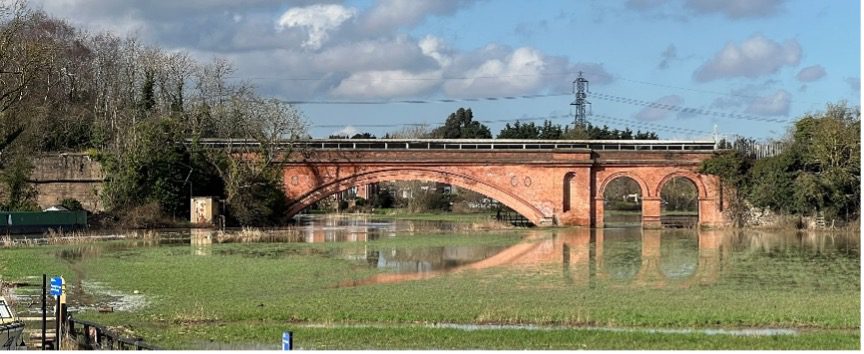
The Midland Railways didn’t continue to monopolise the granite from Mountsorrel for long; in 1898 the Great Central Railway (GCR) drove their own line northward from Leicester through Quorn and created their own spur to the quarry from their Swithland sidings to the quarry. This was closed in 1964 but has now reopened as part of the preserved Mountsorrel Railway.
Despite being sandwiched between the Great Central and Midland Railways, Mountsorrel has never had its own station. The nearest stations were “Barrow upon Soar and Quorn” on the MR and “Quorn and Woodhouse” on the GCR. At one point in the late 1830s an act of parliament was passed that would have allowed the MCR to build a rail spur from near Barrow to opposite the Duke of York pub and the canal – primarily to transport quarried granite by horse drawn trucks; after the amalgamation of the MCR into the MR in 1844, this plan was ultimately shelved in favour of the later 1858 plan.
It’s interesting to see though in the Parliamentary gazetteer of 1845/6 Mountsorrel is described as “7 miles north of Leicester, and 105 North by west of London, a little to the west of the Midland Counties railway, with which it communicates by a branch line.” As far as we known – this was never built!!
A6 Bypass
The final part of transport in the town is the A6 (previously the old turnpike road); until October 1991 the main road through the centre of town was also the main road from Leicester to Loughborough, and also carried all of the quarry’s heavy lorry traffic! Debated in Parliament since at least 1978, the Mountsorrel and Quorn bypass construction was given the go ahead on 18th August 1989. Opening 2 years later it immediately slashed the amount of traffic transiting through the town and took the quarry traffic directly only the A6 bypass via the newly constructed Granite Way.
NORTH/SOUTH SUPERIOR/INFERIOR AND THE COMMON
In 1080, which was approximately when the castle was built, the area was already split between 2 parishes, Barrow to the north (Earl of Chester) and Rothley to the south (Earl of Leicester). As Mountsorrel castle lay pretty much on the border, 2 new areas were set up, Mountsorrel North and South; these were each carved out of the previous parishes but ownership was retained by their previous Lords. These were originally known as Mountsorrel Superior (south) and Mountsorrel Inferior (north) – but not in the modern meaning of the words.
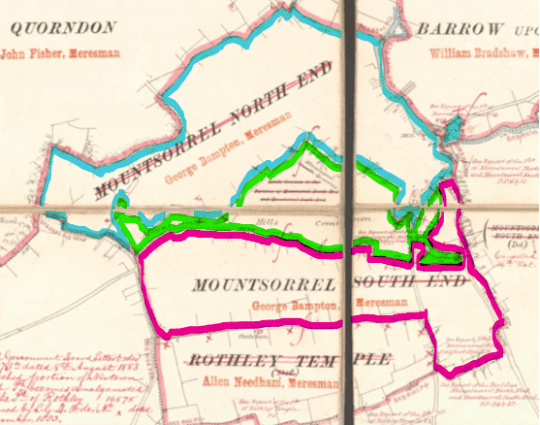
Under the Mountsorrel Enclosure Act of 1782, a pre-existing section of common land situated between the two parishes (the green area on the map above) was confirmed as for common usage; this was a formalisation of an historic area that had already been long in common use, much of the large area in the centre of it though has now been quarried away. The remainder however, forms the heart of Mountsorrel Conservation area that was set up in 1977 along with an area that approximates the town boundary at the end of the 19th century. This Conservation Area sadly arrived too late for many fine but weary buildings in the town centre that were torn down and redeveloped in the 1960s.